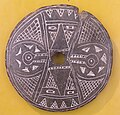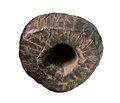
A spindle whorl is a weighted object fitted to a spindle to help maintain the spindle's speed of rotation while spinning yarn.
History
A spindle whorl may be a disk or spherical object. It is typically positioned on the bottom of the spindle. The spinner spins the weighted spindle pulling off a mass of fibers which is twisted into yarn.
Historically, whorls have been made of materials like amber, antler, bone, ceramic, coral, glass, stone, metal (iron, lead, lead alloy), and wood (oak). Local sourced materials have been also used, such as chalk, limestone, mudstone, sandstone, slate, lydite and soapstone.
Natufian artifacts unearthed in Israel at Nahal Ein Gev II, an archeological site, are believed to be the oldest spindle whorls found to date. Archaeologists say the perforated pebbles found scattered at the village site are 12,000 years old. According to scans of the pebbles, the perforations were biconical in shape and drilled in two directions, creating an hourglass shape.
Gallery
-
 Spindle whorl (Sulsultin), Chemainus, Coast Salish (Native American), 19th century, Brooklyn Museum
Spindle whorl (Sulsultin), Chemainus, Coast Salish (Native American), 19th century, Brooklyn Museum
-
 Whorl (12th or 13th century) found in Poland
Whorl (12th or 13th century) found in Poland
-
 Ancient Greek spindle whorls, 10th century BC, Kerameikos Archaeological Museum, Athens
Ancient Greek spindle whorls, 10th century BC, Kerameikos Archaeological Museum, Athens
-
 Muisca spindle whorl (500–1500 AD), Archaeology Museum, Sogamoso, Colombia
Muisca spindle whorl (500–1500 AD), Archaeology Museum, Sogamoso, Colombia
-
 Whorl made of antler, Viking Age (793–1066 AD), Björkö, Sweden
Whorl made of antler, Viking Age (793–1066 AD), Björkö, Sweden
-
 Saltfleetby spindle-whorl (10th–12th centuries), Lincolnshire, England
Saltfleetby spindle-whorl (10th–12th centuries), Lincolnshire, England
References
- Yashuv, Talia; Grosman, Leore (2024-11-13). "12,000-year-old spindle whorls and the innovation of wheeled rotational technologies". PLOS ONE. 19 (11): e0312007. doi:10.1371/journal.pone.0312007. ISSN 1932-6203. PMC 11559986. PMID 39536041.
- Lesté-Lasserre, Christa (2024-11-13). "12,000-year-old stones may be oldest example of wheel-like tools". New Scientist. Retrieved 2024-11-16.
- "Earliest Spindle Wheels May Have Been Discovered in 12,000-year-old Village in Israel", Haaretz